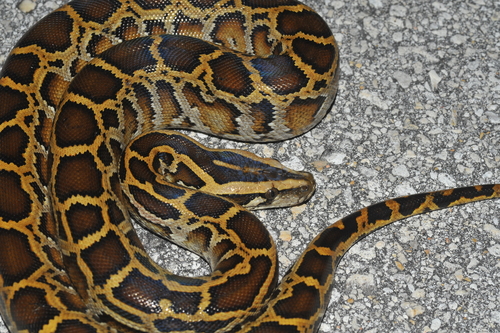
Burmese Python
The Burmese python, Python bivittatus, is a colossal constrictor of Southeast Asia's jungles. Renowned for its striking patterned scales and jaw-dislocating feeding prowess, this snake plays a pivotal role in its ecosystem, controlling prey populations. Despite its size, it silently navigates its lush habitat, a true marvel of nature.
20 years
Lifespan
90.7185 kg
Weight
Length: 7.01 m
Size
Brown, Black, Tan
Color
18-48 months
Age of Sexual Maturity
1 mph
Top Speed
Vulnerable
Conservation Status
Decreasing
Population Trend
Characteristics
Python bivittatus, commonly known as the Burmese python, is one of the largest snake species in the world. Native to Southeast Asia, it thrives in tropical and subtropical environments. This constrictor is known for its distinctive dark brown blotches on a tan body, and its incredible ability to consume prey much larger than its head by dislocating its jaw.
Distribution Range of the Burmese Python
Python bivittatus, commonly known as the Burmese Python, is native to Southeast Asia. Its geographical distribution includes countries such as Myanmar, Thailand, Laos, Vietnam, Cambodia, and parts of Indonesia (Java, Bali, and Sulawesi). The species is also found in the southern regions of China and India.
Burmese Python's Habitat
Environmental Conditions
The Burmese Python typically inhabits tropical and subtropical environments. It thrives in a variety of habitats including grasslands, marshes, swamps, and jungles. This species is often found near water bodies as it is an excellent swimmer. The climate in these regions is generally warm and humid, with distinct wet and dry seasons.
Ecological Niche
As a large constrictor snake, the Burmese Python plays a significant role as both predator and prey within its ecosystem. It primarily preys on birds and mammals, controlling populations of various species. The python's ability to adapt to different environments, including agricultural lands and urban areas, highlights its ecological flexibility.
Copyright @ Nature Style Limited. All Rights Reserved.
 English
English